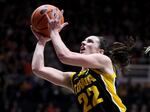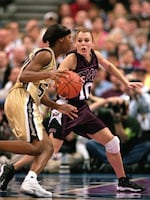
Caitlin Clark shoots the ball against the Purdue Boilermakers in January in West Lafayette, Indiana.
Andy Lyons / Getty Images
Iowa's Caitlin Clark has captured the NCAA's women's all-time points record, surpassing 3,527 points on Thursday against the Michigan Wolverines.
The Hawkeyes guard overtook previous record holder Kelsey Plum in 13 fewer career games, while taking fewer shots. Her deep 3-point shot, showmanship and competitive intensity have sold out arenas, where seats go for hundreds of dollars, and broken TV viewership records.
Loading...
Her feat is a transcendent moment for the game and the fulfillment of both Clark's promise and Title IX's. Her ascendance is emblematic of a surge in women's hoops, in popularity and quality of play, and in financial and media interest.
Ahead of the class
The college senior has outpaced the modern elite hooper since grade school.
"I never heard of her until after I was hired," says Kristin Meyer, who was Clark's head coach at Dowling Catholic High School in West Des Moines, Iowa.
Meyer first saw Clark, who is now 22, play as an eighth grader. "Right away ... you just saw that she saw the game at a different level," Meyer says. "She was taking shots that high school and college women wouldn't take."
The difficulty rested in finding new ways to challenge Clark.
"We had to bring in different high school guys who were a little bit stronger, a little bit taller, and who could guard her more," Meyer says. "I just remember her just being so excited to get to go against the guys and challenge them. She'd score a basket, talk a little trash or they'd get a stop and they talk a little trash, all in fun."
When Clark left high school, Meyer thought she'd score 20 to 25 points a game her freshman year at Iowa.
Meyer was slightly off. Clark averaged 26.6 points per game her freshman season, while shooting just over 40% from 3-point range. The next season, Clark’s sophomore campaign, her average crept up to 27 points per game. Her junior year stats didn’t move much — proof she’s human — but her 3-point shooting did rub up against 39%.
Loading...
Fast forward to today: Clark's exceeding her own metrics, averaging more than 32 points, seven rebounds and almost eight assists per game.
Clark's career average from the 3-point range may indeed be just over 38%, but her average distance during the 2022-2023 season was 25 feet, 11 inches — about 4 feet farther out than the men's and women's 3-point line. Three-point shots made 25 feet and out have been affectionately dubbed "logo 3s." While the shot may not be from the literal half-court logo, the 3-point shot flirts with it.
Loading...
Game recognizes game
To witness greatness is to have known excellence, then see it effortlessly exceeded. That's the reality for the college basketball greats observing Clark's journey.

Jackie Stiles, right, in 2001.
Andy Lyons / Getty Images
Jackie Stiles is one of those watching. The Hall of Fame guard from Missouri State held the all-time points record from 2001 to 2017.
"To see somebody so dominant in their craft — it just brings even non-sports fans to follow her and be inspired by her," Stiles says.
Those fans are waiting in ever-longer lines for autographs, selfies and pictures with the stars of women's hoops. ("I would never turn down an autograph," Stiles recalls.)
While Stiles didn't play in the social media era, fandom then was as relentless as it is today. "It got to the point where I could hardly warm up for games, because the fans were coming out onto the court," she says.
Stiles sees in Clark a role model for young fans. "You have little girls watching Caitlin Clark on TV, wanting to be like her. ... From a young age, they have somebody to idolize," Stiles says. "I told my second grade teacher I was going to play professional basketball when I grew up, but the WNBA didn't exist."
Clark has talent and practice to thank for her ascendance, but there's an element of right place, right time, too.
"No one has been able to capture the kind of magic or lightning in a bottle like Caitlin Clark has done," says Mary Jo Kane, professor emeritus and founding director at the University of Minnesota Tucker Center for Research on Girls & Women in Sport. "A lot of that is timing — she is riding the crest of all of the advancements that have been made 50 years plus in the wake of Title IX."
Title IX, which prohibits sex-based discrimination within educational settings, passed in 1972. Since then, young women have increasingly had access to greater coaching, competition and facilities.
"We have gone from young girls hoping that there is a team to young girls hoping that they make the team," Kane said. "For the first time ever in our history, young girls today grow up with a sense of entitlement to sports."

Young fans hold signs for Caitlin Clark prior to the game against the Northwestern Wildcats on Jan. 31, in Evanston, Ill.
Michael Reaves / Getty Images
The "Caitlin Clark effect"
Clark's sway is similar to Stephen Curry's among young players.
Consider the frequent comparisons to the Golden State Warriors guard: Both Curry and Clark have illimitable range, and that's helped redefine what makes a good shot. And while they are remarkable shooters, they aren't ball hogs. They're both selfless passers who champion basketball's emphasis on sharing the ball.
"We're going to see over the next five to 10 years so many more players who are pushing those boundaries like Caitlin has," Meyer says. "You're going to see the logo 3s become so much more popular. You're going to see the step backs and the off the dribble and in different things that people are trying to emulate."
Clark is an "unprecedented tsunami of impact and influence," says Kane.
"Just in terms of her athletic excellence alone, she is off the charts," Kane says. "Then we can also talk about her as a marketing phenom and the kind of economic impact that she has."
Take University of Iowa Athletics, whose total revenue from fiscal year 2023 was almost $16 million more than in 2022. Behind that boost are ticket sales from men's football and women's basketball. Women's hoops almost doubled in ticket revenue.
Loading...
Thus far, every Iowa Hawkeyes road game has been a sellout. Schools such as Northwestern University have set attendance records just from hosting Clark and her team.
Clark is also her own sales juggernaut. With Name, Image and Likeness being the law of the land, athletes like Clark — not just university and athletic apparel brands — get a piece of the pie. (NIL is the NCAA policy, adopted in 2021, that allows college athletes to make money off their name, image and likeness.)
Clark's NIL value is in the millions, with sponsorships including State Farm, H&R Block, Goldman Sachs and, of course, Nike and Gatorade.
When Stiles entered the WNBA as the fourth pick in 2001, her salary was $55,000.
"She won't have to work a day in her life after her basketball career ends if she's halfway smart with her money," Stiles says. "I would not have to be working right now if I got to be compensated like that — it's pretty amazing to see."
Clark sparks joy
Cleveland hosts the women's Final Four this year, and Iowa is a favorite. But it won't be easy. Competition will come from Dawn Staley's South Carolina Lady Gamecocks and Tara VanDerveer's Stanford Cardinals, to name two.
Whatever happens, Clark's gravitational pull on basketball will only intensify, as thousands feed off her joy for the game, joy of competition and joy for the upward trajectory of women's basketball.
Joy serves as that extra lift in the legs of this lethal long-range bomber who has quickly joined the game's greatest shooters.
That joy was on display on Feb. 3, when Clark and the Iowa Hawkeyes visited the Maryland Terrapins in another sold-out venue.
The game was electric by all standards — both in-person and for fans watching at home. It attracted almost 1.6 million viewers on Fox Sports, a network record for women's basketball.
After the game, NPR's Scott Detrow asked Clark about how she handles the pressure.
"Whenever I step on the court, I just want to have a lot of fun," she said. "I've been able to find a lot of joy and calmness in that."
Copyright 2024 NPR. To see more, visit https://www.npr.org.